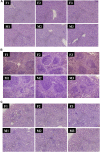Broad-host-range Salmonella bacteriophage STP4-a and its potential application evaluation in poultry industry
- PMID: 32616261
- PMCID: PMC7597861
- DOI: 10.1016/j.psj.2020.03.051
Broad-host-range Salmonella bacteriophage STP4-a and its potential application evaluation in poultry industry
Abstract
Salmonella is regarded as the predominant cause of foodborne illnesses worldwide, and the increase of these antimicrobial-resistant strains makes it more difficult to prevent. On this occasion, bacteriophages (phages) stand out as an alternative biocontrol agent with high efficiency and low mutation rates. Salmonella phages have confronted challenges to counteract with more than 2,500 serovars of Salmonella spp. and overcome the universality of antibiotics to different species, and thus, broad-host-range phages infecting Salmonella spp. are urgently required to realize precise poultry treatment or clinical therapy. First, phage STP4-a was screened to have a broad host range through bioinformatics analysis, and then the host range assay proved that phage STP4-a could inhibit 88 out of 91 Salmonella strains. Then, in silico analysis excluded the possibility of phage STP4-a possessing any known lysogeny factors, toxins, pathogen-related genes, or foodborne allergens, and oral toxicity studies further ensured the safety of unknown factors or suspected risks. In addition, strong inhibition effects of phage STP4-a were seen on both single Salmonella strain and multiple Salmonella strains in vitro, reducing 3-5 log in 30 min. Phage STP4-a could survive and keep more than 50% activity in simulated stomach or intestine environments in vitro. In terms of antimicrobial activities in chickens, pretreatment with phage STP4-a was the most efficient approach to Salmonella biocontrol, non-detectable in feces during the 14-day experimental period. Therefore, phage STP4-a was an extremely broad-host-range and safe biocontrol agent, performing its potential as a food additive or therapeutic drug in poultry industry.
Keywords: Salmonella bacteriophage; antimicrobial activity; broad-host-range; poultry industry; safety.
Copyright © 2020. Published by Elsevier Inc.
Figures




References
-
- Bren L. Bacteria-eating virus approved as food additive. FDA Consum. 2007;41:20–22. - PubMed
-
- Carlton R.M. Phage therapy: past history and future prospects. Arch. Immunol. Ther. Ex. 1999;47:267. - PubMed
-
- Carlton R.M., Noordman W.H., Biswas B., de Meester E.D., Loessner M.J. Bacteriophage P100 for control of Listeria monocytogenes in foods: genome sequence, bioinformatic analyses, oral toxicity study, and application. Regul. Toxicol. Pharmacol. 2005;43:301–312. - PubMed
MeSH terms
Substances
LinkOut - more resources
Full Text Sources
Molecular Biology Databases
Miscellaneous

